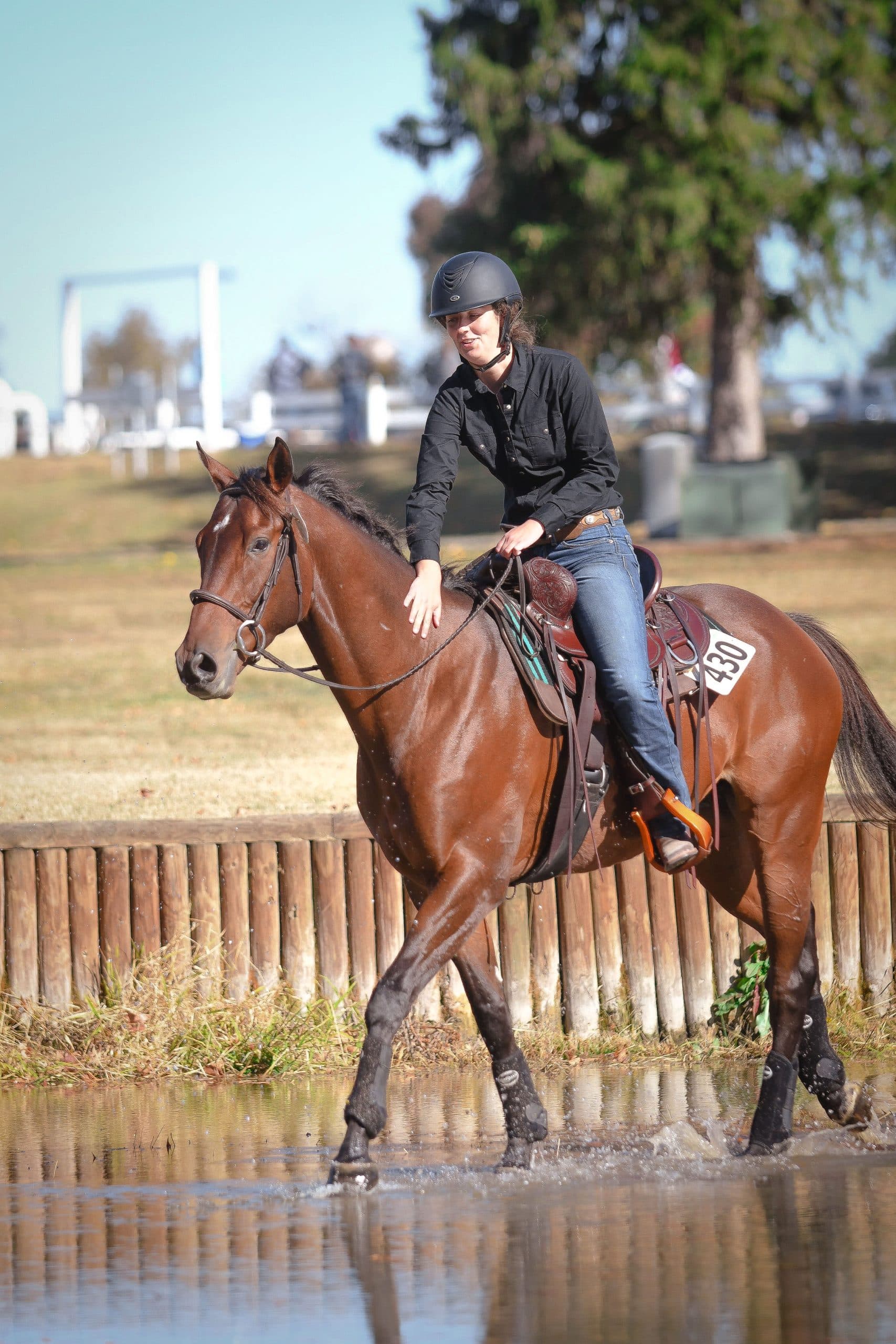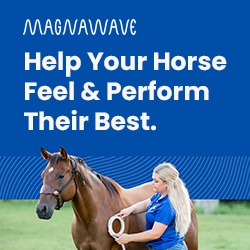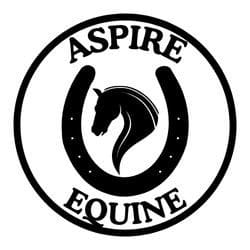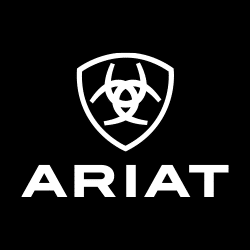
Rewards don’t have to be treats; they can be scratches and verbal cues, as well. Photo courtesy CanterClix
Your horse has never liked water — he’ll sidestep puddles and hesitate before walking into a wet wash rack. Today, however, you’ve come to a creek crossing on the trail that he can’t step over or go around. Fortunately, you’ve done your homework: He takes a cautious step toward the water, and you scratch his withers. Another step, another withers scratch. After a few more scratches of encouragement, you’re both on the other side of the stream.
This is a classic example of positive reinforcement. Positive reinforcement training is a type of operant conditioning that is based on the stimulus-response-consequence relationship. A trainer uses reinforcement training anytime he or she wants to increase the frequency of a behavior (as opposed to punishment, where the goal is to reduce the behavior’s frequency). In terms of learning theory, positive refers to the addition of a stimulus. Therefore, positive reinforcement training occurs any time the trainer adds something the horse sees as positive to reinforce the desired behavior.
“For instance, when we expose a horse to a novel stimulus (e.g., a tarp), this causes the horse to respond in a certain way, such as snorting or taking a step toward the object,” says Tanja Bornmann, MSc, Cert. ABW, equine researcher and founder of Academic Equitation, in Ontario. If approaching the frightening object is the trainer’s desired response, he or she can reinforce that response by giving a food reward or praising the horse, she says. This creates the association between the desired behavior and a positive response in the horse’s mind.
“If I have a horse that is difficult to catch, I might give the horse a treat each time it approaches me, then progress to only giving the treat when the halter is on,” says Camie Heleski, PhD, senior lecturer in the University of Kentucky’s Department of Animal and Food Sciences, in Lexington.
With positive reinforcement training, you can use both primary and secondary reinforcers to reward your horse for correct behavior. Primary reinforcers are natural to the horse or fulfill a basic need, such as food. Secondary reinforcers are less natural and, therefore, the horse must first learn their positive meaning by associating them with a reward. This training strategy takes longer for the horse to learn but can be just as effective — and sometimes more so — as using primary reinforcers. Trainers can use voice cues or the sound of a clicker as secondary reinforcement.
Clicker training is one form of positive reinforcement training, says Bornmann. “The clicker bridges the gap between displaying the correct behavior and the reward.” Target training is another form of positive reinforcement, where the horse learns to approach, touch and follow a target, receiving a reward when he does so, she adds.
Positive Reinforcement for OTTBs
When retraining OTTBs for second careers, you can use positive reinforcement in both your groundwork and under saddle. Like any breed, not all Thoroughbreds associate humans with positive experiences, so take the time to build trust and create a positive relationship, says Bornmann. Positive reinforcement training can create positive associations between horses and their humans, she adds.
The beginning of the retraining process is a great time to integrate positive reinforcement into your horse’s routine. This can be as simple as getting him comfortable in his new environment or teaching him to approach when called.
For each new task, Heleski says she assumes the horse does not know it. If success comes easily, she moves to a more challenging task.
Many OTTBs, for instance, do not know how to stand at the mounting block because it was not part of their training routine at the track. “Understanding this background is half the battle when teaching your OTTB new concepts,” says Heleski. First, spend ample time getting the horse accustomed to all sides of the mounting block. “A fair bit of work can be done from the ground, when the horse is tacked up,” she says. “You can simply walk the horse to the block, ask them to stand still (some people even use a verbal cue) and reward with food or scratches when they stand quietly.”
When the horse is ready to move to the next step, a second person should help, so one can hold and reward the horse and the other can mount. The person on the ground should ask the horse to stand still while the rider mounts. Once the rider mounts, the ground person should reward the horse. For some horses this can all be done in one session, while it might take others days or even weeks, says Heleski.
Bathing in a wash rack can be another foreign experience for young OTTBs that have only been hosed or bathed using buckets in an open area. “Therefore, I have my pockets full of a food reinforcer, and I start by walking a few steps toward the wash rack and giving the horse a treat when we get close,” says Heleski. “I continue to get closer until I see signs that he is becoming nervous. Then I stop, which is very important, wait for him to relax and give him a treat when he does. I repeat this until he calmly walks into the wash rack.”
Timing of the reward is crucial for success. As soon as your horse offers the first sign of the desired behavior, click a clicker or verbally praise him and then quickly give him a treat. Work in tiny increments, and keep training sessions short — just 10 to 15 minutes — to avoid the horse becoming frustrated or distracted. Also be consistent in how you ask for and reward a behavior to prevent your horse from becoming confused or inadvertently encouraging the wrong behavior. It might take several sessions to achieve your final training goal, says Bornmann.
Once you and your horse understand positive reinforcement training, you can apply it in almost any situation. “Wither scratching, for instance, has been shown to reduce stress and increase relaxation,” which can be useful when taking your OTTB off property, says Bornmann.
Before taking your horse to a new location, however, make sure he’s confident with the tasks you want him to perform at home. “Always ‘proof’ the desired behavior in different locations,” says Heleski.
Because noisy or crackling announcement systems can cause some OTTBs to become excitable, Heleski recommends arriving at a horse show early to hand-walk the horse and let him take in the environment before hopping on. “If there is grass nearby, I like to let the horse graze as reinforcement for calm behavior,” she says. “If there is no grass, I keep treats in my pocket to reward moments of calm, such as relaxation of their eyes and ears or taking a deep breath.” Repeat this process until the horse remains consistently calm in that environment.
Common Misconceptions
Common fallacies about positive reinforcement include:
1. The horse will become pushy and “treat-obsessed” if he’s trained using treats, and he will demand a reward every time he’s asked to do something.
2. The horse will gain weight because of the treats.
3. The horse will become disinterested in the work after a certain period.
4. Positive reinforcement training doesn’t work with horses that are not treat-obsessed.
A safe horse-human interaction is always the top priority, so it is important to follow “treat etiquette” to avoid creating a pushy or treat-obsessed horse, says Bornmann. “Keep the horse from taking the treat from your pocket,” she says. “Ask him to wait patiently and quietly (as opposed to pawing or wiggling around) until you are ready to reward him.”
You might even teach your horse polite treat behavior before starting true positive reinforcement training.
A common mistake many trainers make is becoming impatient and frustrated when horses do not show immediate progress. “Refrain from expecting too much from your horse, and reward small learning achievements,” says Bornmann.
Take-Home Message
Positive reinforcement training can help you build a trusting relationship with your OTTB. “I see it as building up a ‘trust account’ with the horse,” says Heleski. When you build this trust through positive reinforcement, the horse is more likely to handle aversive situations better, she adds.
If done correctly, positive reinforcement training can reduce stress and increase motivation and learning success. Researchers suggest positive reinforcement training might even increase horses’ overall willingness to seek physical contact with humans, says Bornmann.










